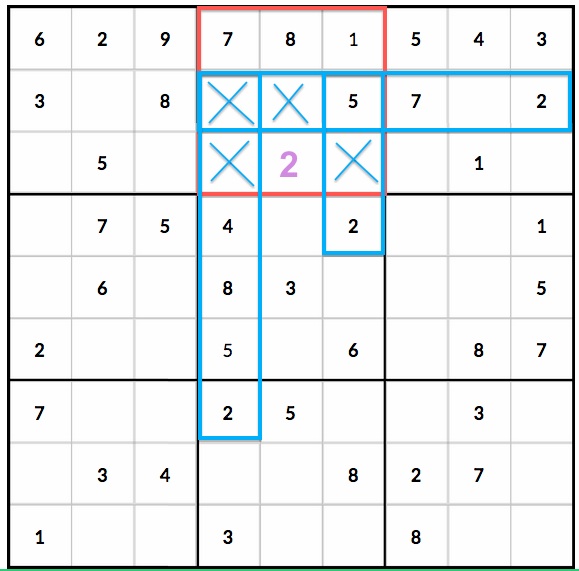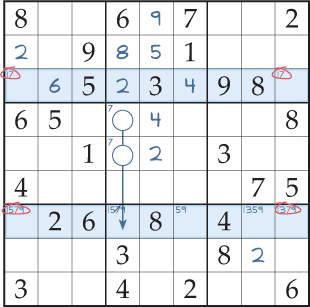

The example shows that row number 1 and row number 5 both have a cell in the same column containing only the candidate numbers 4 and 7. This means, we can eliminate 8 from the upper and lower rows in the middle-right column. In the middle and the middle-left blocks, the number 8 must be placed in one of the red cells. This technique is best understood by looking at the example. Thus you can remove 7 as a possible candidate from the rest of the row. The example shows that the number 7 can only be inserted in the red cells of the middle row. This method won't help you pencil in any new numbers, but it will help you nail a number down within a specific row or column. This example illustrates the number 4 as the unique candidate for the cell marked in red. Therefore, if a number, say 4, can only be put in a single cell within a block/column/row, then that number is guaranteed to fit there. You know that each block, row and column on a Sudoku board must contain every number between 1 and 9. In this example, the red cell can only contain the number 5, as the other eight numbers have all been used in the related block, column and row. This happens whenever all other numbers but the candidate number exists in either the current block, column or row. When a specific cell can only contain a single number, that number is a "sole candidate". You should be able to solve almost any Sudoku puzzle using these techniques. Then, start with the basic techniques again, and repeat the process. Do one at a time until you can plot one more number into a cell. Then, when you can add no more numbers to the board using the basic techniques, try the more advanced ones. Use the first few techniques to insert as many numbers as you can. When utilizing these techniques, the way the pros prefer to do it, is to start with the basic ones. This article presents nine such techniques in increasing difficulty. Solving a hard Sudoku puzzle will require quite a different set of techniques compared to an easy one. Their approach, though, may not be the same. Whenever they play a puzzle tailored for their level of competence, both the beginner and the experienced Sudoku solver will have to put a good amount of thought and technique into completing the task. If you can find two columns with only two identical positions for a given pencil mark, then the corresponding rows intersecting these positions can have all other candidates safely removed.One of the greatest aspects of Sudoku is that the game offers engaging challenges to both the novice, as well as the seasoned puzzle player.

Of course, this whole concept can be rotated. In Sudoklue, the same pencil mark highlighting feature that helps me find hidden singles and omissions, can make X Wings easier to spot as well. Knowing that, all other 4s in the columns are not possible, and can be erased (erase all the pink 4s).Īgain, this is one of those hard to find methods.

Based on what we said above, the 4s in these columns must exist where these two rows cross - that is, where the blue 4s are. Now if we think about this, we know that each of these rows has to have a 4, right? And we also know the 4s cannot be on top of each other, because that would put two 4s in the same column.īecause of this, we can safely assume that either the light blue cells or the dark blue cells must be 4s.Īrmed with this, let's zoom out all the way and shift our focus to the columns involved here (indicated with arrows below). Next, if we zoom out a bit, we can see that another row, two rows down, has the same two 4s, and in the same two spots: Here we see a row containing exactly two 4s: If you can find a row that contains the same pencil mark in exactly two spots, as well as another parallel row that mirrors it - containing the same pencil mark in only the same two spots, then you can use this information to eliminate similar pencil marks in the columns passing through those spots. It starts with either two parallel rows or two parallel columns. An X Wing is a technique for removing candidates (pencil marks).


 0 kommentar(er)
0 kommentar(er)
